7 June 2019
A walk along the D&R Canal Towpath trail at low tide revealed small sandbar islands that are now well vegetated with wild rice (Zizania aquatica) seedlings already more than a foot tall. It’s the only grass growing in that habitat.
This annual, an obligate wetland species, can grow to more than 10 feet by the end of the growing season. After flowering in August and setting seed, it will die. Its seeds are a favored food of many birds including black birds, such as Red-winged Blackbirds and Grackles, and migrant ducks.
Interestingly, there is no evidence of use of Wild Rice by Native Americans in the Delaware River Valley although northern tribes used it extensively. Much of what’s sold commercially is grown in Minnesota and California.
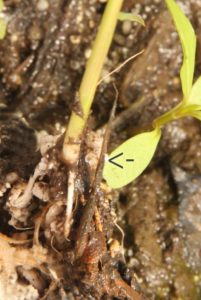 The slender seeds are more than one inch long with a needle-like extension, called an awn, making up part of its length. From this seed first emerges a stem, know as the hypocotyl, and then the shoot. Roots take a bit more time. As human food, they are gluten free, and provide fiber and various nutrients.
The slender seeds are more than one inch long with a needle-like extension, called an awn, making up part of its length. From this seed first emerges a stem, know as the hypocotyl, and then the shoot. Roots take a bit more time. As human food, they are gluten free, and provide fiber and various nutrients.
Seeds cannot be dried. Early colonists were not successful in bringing them to Kew Gardens in England until it was discovered that seeds needed to be stored in water.
Wild Rice can be found throughout the wetlands of the Abbott Marshlands. Young plants can tolerate being inundated. Look for them in mucky places, the bottoms of small tidal streams, shallow ponds, and in the abandoned canal along the towpath trail where there are often dense grouping of light-green plants. Wild rice is a grass like corn or your lawn.
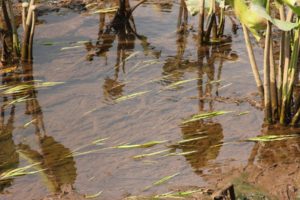
Wild Rice seedlings (May 25) in a tidal channel at low tide.
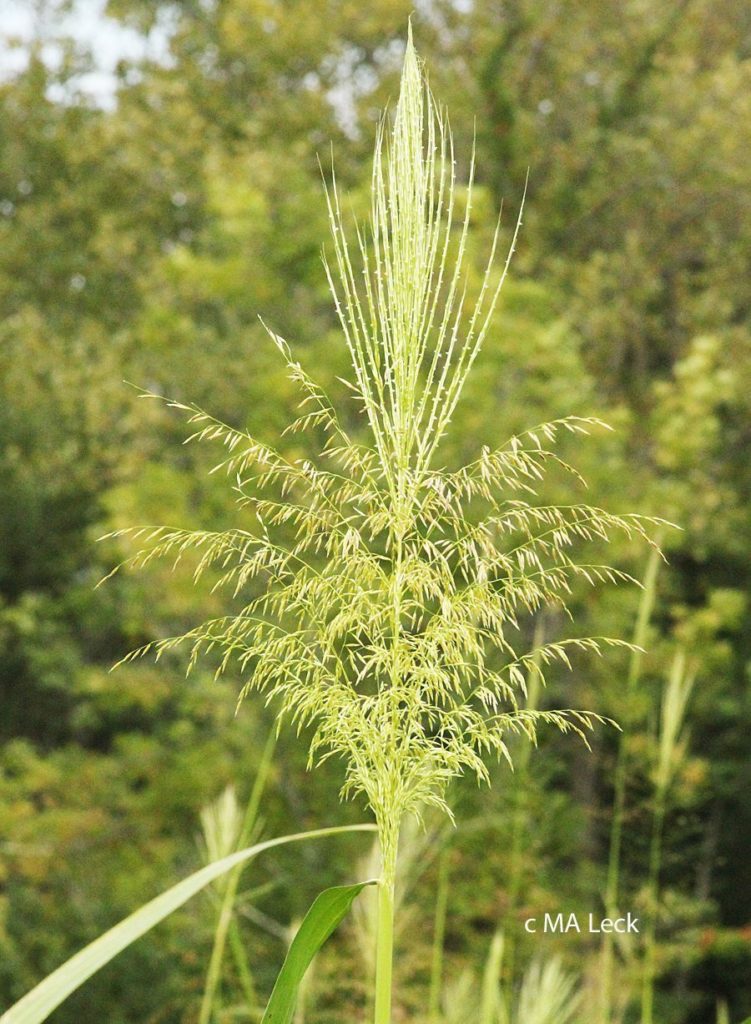
When wild rice flowers, the male flowers will be below the female ones. When in flower, the yellow male flowers make the plants obvious along the marsh waterways.
Wild Rice inflorescence. Female flowers at top, male flowers below. (Aug. 26).
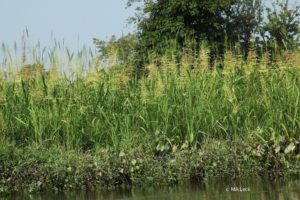
Wild Rice along Crosswicks Creek (Aug. 26).
This is one of the food plants for caterpillars of the Broad-winged Skipper. Adults (~0.8 inch) obtain nectar from dogbane, swamp milkweed, pickerelweed, thistles, etc.
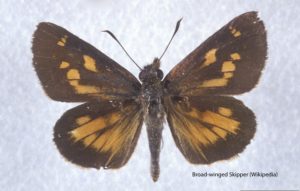 Broad-winged Skipper (Wikipedia)
Broad-winged Skipper (Wikipedia)
Because of the economic value of wild rice for human consumption, much research has been focused on learning how to germinate seeds. Early work showed that seed dormancy can be broken by prolonged cold treatment (e.g., 3-6 mo at 1-3 C; 21-37 F) at low oxygen levels, as would occur if submersed in water or in mud at the bottom of a tidal stream. (Although many factors can influence the actual amount of oxygen in water such as temperature and wind, the content of air is 20%, while that of water is 1%, which is why people drown).
Botanical facts: The Wild Rice species found in the marsh is Zizania aquatica a member of the grass family (Poaceae) like corn or your lawn grass. There are three other Zizania species: Z. palustris is found in northern areas (Minnesota, Wisconsin, Canada) and Z. texana, a perennial species now endangered, occurs in central Texas; Z. latifolia, Manchurian Wild Rice, now rare in nature is native to Asia, where it is cultivated for its stems that are eaten as a vegetable.
Like corn, Wild Rice is monoecious, with both male and female flowers on the same plant, but in Wild Rice, the male flowers, where pollen is produced, are located below female ones. Male flowers are typically yellow, but may sometimes are reddish.
Seeds can remain dormant for more than a year. This can account for field observations that some years in some locations in the Abbott Marshlands there may be few or no Wild Rice plants. Long seed dormancy poses problems for plant breeders who desire multiple crops per year, and for growers who wish to change varieties in established fields. However, freshly harvested seed can be germinated, if first dehulled by scraping and stored 1-4 weeks at 1.5 C (35 F).
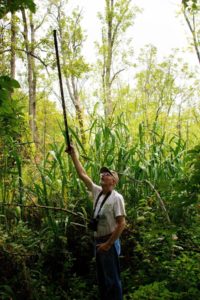
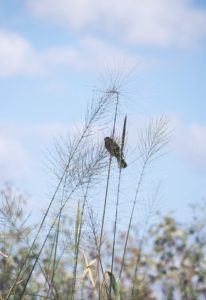
Red-winged Blackbird feeding on Wild Rice. Warren Libensperger showing height of Wild Rice (Sept. 1).
Resources:
For tides, consult the marsh website (www.abbottmarshlands.org -Tides) or local newspapers.
Background and for use of Wild Rice by Native Americans and other background see https://en.wikipedia.org/wiki/Wild_rice
For use in the Delaware River Valley:
Messner, Timothy. 2011, Acorns and Bitter Roots: Starch Grain Research in the Prehistoric Eastern Woodlands. University of Alabama Press, Tuscaloosa. (p. 21).
Also: Personal Communication, Michael Stewart, June 10, 2019.
Germination
Cardwell, V.B., E.A. Oelke, and W.A. Elliott. 1978. Seed dormancy mechanisms in Wild Rice (Zizania aquatica). Agronomy Journal 70 (3): 481-484.
Whigham, D.F. and R.L. Simpson. 1977. Growth, mortality, and biomass partitioning in freshwater tidal populations of wild rice (Zizania aquatica var aquatica). Bulletin Torrey Botanical Club 104: 347-351.
Mary A Leck,
Emeritus Professor of Biology, Rider University
Friends for the Abbott Marshlands
[email protected]
